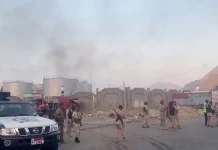DM Monitoring
BEIJING: China on Monday rejected Indian army’s accusations that Chinese troops violated the previous consensus and said its border troops always strictly abide by the Line of Actual Control (LAC) and never cross it in Ladakh.
“Chinese border troops always strictly abide by the LAC. They never cross the line,” Chinese Foreign Ministry’s Spokesperson Zhao Lijian said during his regular briefing while responding to a question regarding Indian military’s statement alleging the Chinese troops of carrying out provocative military movements to change status quo. “The border troops on the two sides had been in close communication regarding the issues on the ground,” he added.
Indian army said in a statement on Monday that the People’s Liberation Army (PLA) “violated the previous consensus reached in previous military and diplomatic engagements and carried out provocative military movements to change the status quo” in the disputed eastern Ladakh region on the night of August 29/30. It said Indian soldiers foiled the Chinese attempt.About any meeting going on to resolve the issue, he said, “What I said is that the two sides through diplomatic and military channels maintain close communication. As to specific meetings and talks, if there is anything we will release it in timely manner.”
The Galwan Valley, which is part of the disputed region, is located on the Chinese side of the Line of Actual Control in the western section of the Sino-Indian border. And Chinese soldiers have patrolled the area for many years, according to China’s Defense Ministry.
China blames India for escalation in the Galwan Valley, and it has called on the Indian side to settle the dispute through military and diplomatic dialogue. It may be mentioned here that on May 6, Indian soldiers’ first intrusion in the China-controlled Galwan Valley. On June 15, the Chinese and Indian soldiers engaged in a nightly medieval clash in Galwan Valley, where India was trying to build a strategic road connecting the region to an airstrip close to China.As many as 20 Indian soldiers were killed during the fight. Since then the two countries have held several rounds of commanders’ level talks to ease the situation on the border in Galwan Valley.
The disputed border covers nearly 3,500 kilometers (2,175 miles) of frontier that the two countries call the Line of Actual Control and that stretches from Ladakh in the north to the Indian state of Sikkim in the northeast. The two countries have been trying to settle their border dispute since the early 1990s without success. Since then, soldiers from the two sides have frequently faced off along the contested frontier. India unilaterally declared Ladakh a federal territory while separating it from disputed Kashmir in August 2019. China is among the countries to strongly condemn the move, raising it at international forums including the United Nations Security Council (UNSC).
Moreover, India and China accused each other on Monday of military provocation on their contested Himalayan border where a deadly showdown erupted in June even as commanders from the two sides held talks aimed at easing tensions.
China’s military said Indian troops had crossed the border on Monday near Pangong Tso, a lake at 4,200 metres, and engaged in “open provocation and caused the border situation to become tense”.
“The Chinese military is taking necessary countermeasures,” the People’s Liberation Army’s regional command said in a statement, accusing India of “seriously violating China’s territorial sovereignty”.
Earlier on Monday, India’s defence ministry said Chinese troops had “carried out provocative military movements to change the status quo” in the eastern Ladakh region over the weekend.
Military commanders from the two sides held talks on Monday in a new bid to ease tensions between the nuclear-armed neighbours, who fought a border war in 1962 and have staged regular high altitude clashes since. China did not confirm Saturday’s incident, but the foreign ministry said its troops have “always strictly respected” the unofficial border known as the Line of Actual Control.
On June 15, troops from the two sides fought hand-to-hand combat in Ladakh in which 20 Indian troops were killed. China acknowledged casualties but did not give figures. The two sides blame each other for recent clashes and the two armies have since poured tens of thousands of troops into the region. Military and diplomatic talks are at an apparent stalemate.
Pangong Tso is one of several hotspots where troops have massed since June. “Indian troops pre-empted this PLA activity on the southern bank of Pangong Tso lake, undertook measures to strengthen our positions and thwart Chinese intentions to unilaterally change facts on ground,” said India’s defence ministry. Senior officers met at a border post near the scene of the standoff on Monday, it added.
According to Indian military sources, speaking on condition of anonymity, Indian troops pushed back Chinese troops who crossed the Line of Control. “PLA soldiers walked into our area near the south bank of Pangong, but our soldiers were prepared and quickly pushed them back without any violence,” said one source. “They tried to come in again several hours later but we stood firm. There has been no such confrontation in this area in the past.” China’s foreign ministry said Chinese troops “have always strictly respected the Line of Actual Control and never crossed the line”.
“Border troops from both sides have maintained communication over issues on the ground,” foreign ministry spokesman Zhao Lijian told a press briefing. Amid calls for boycotts of Chinese goods, India has stepped up economic pressure on China since the June battle and repeatedly warned that relations would suffer unless its troops pull back. India has banned at least 49 Chinese owned-apps including the TikTok video platform frozen Chinese firms out of contracts and held up Chinese goods at customs posts.
China has complained about the action and warned that Indian consumers will suffer.




